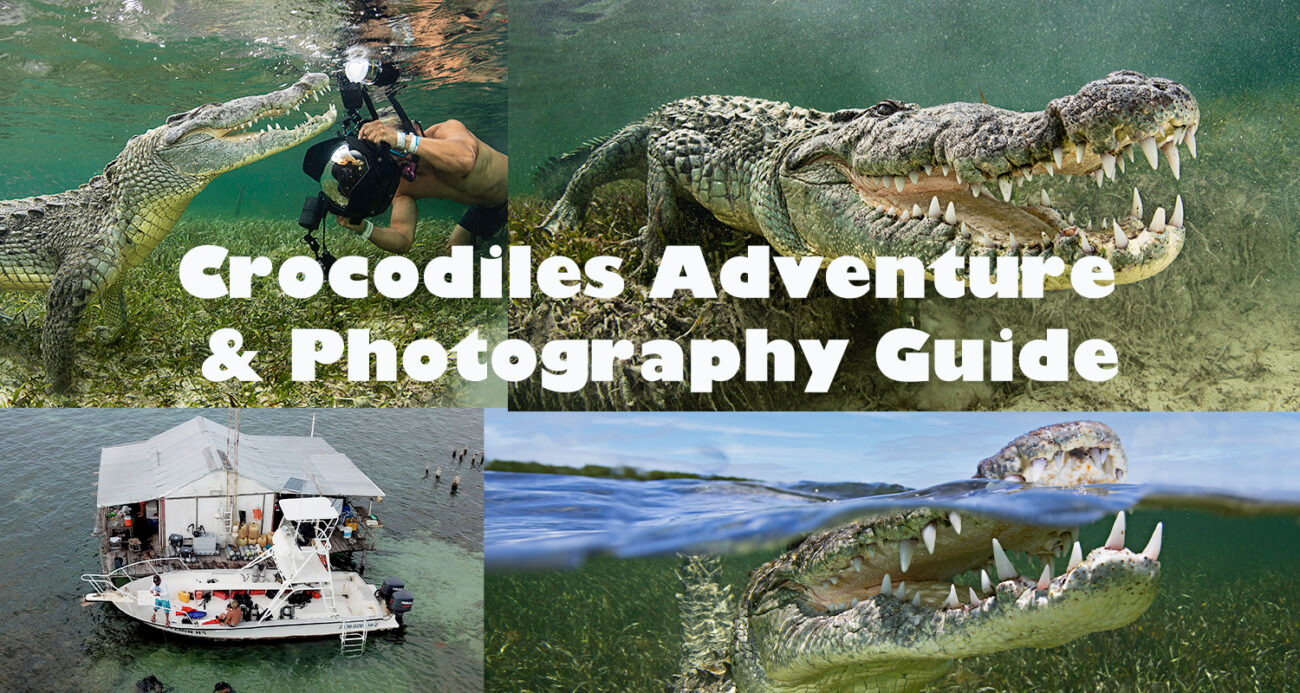
See a schedule of my Crocodile Adventures with prices and details and all my underwater photography Trips on my Website
Contact me now to get one of the last spaces on this rare adventure
Opportunities to dive with and photograph sharks are numerous all over the world, but chances to get photographic quality encounters with reptiles is scarcer. Some species of crocodiles or alligators are too dangerous for most to do safely, but the American Crocodiles of Banco Chinchorro , Mexico are of such a nature that one can get close to them safely in the shallow, clear, warm water. This is a rare opportunity to get close to a misunderstood, rare, and dangerous marine animal in a situation as safe as possible. Getting to them is a pleasant adventure to a remote location few are allowed to visit.
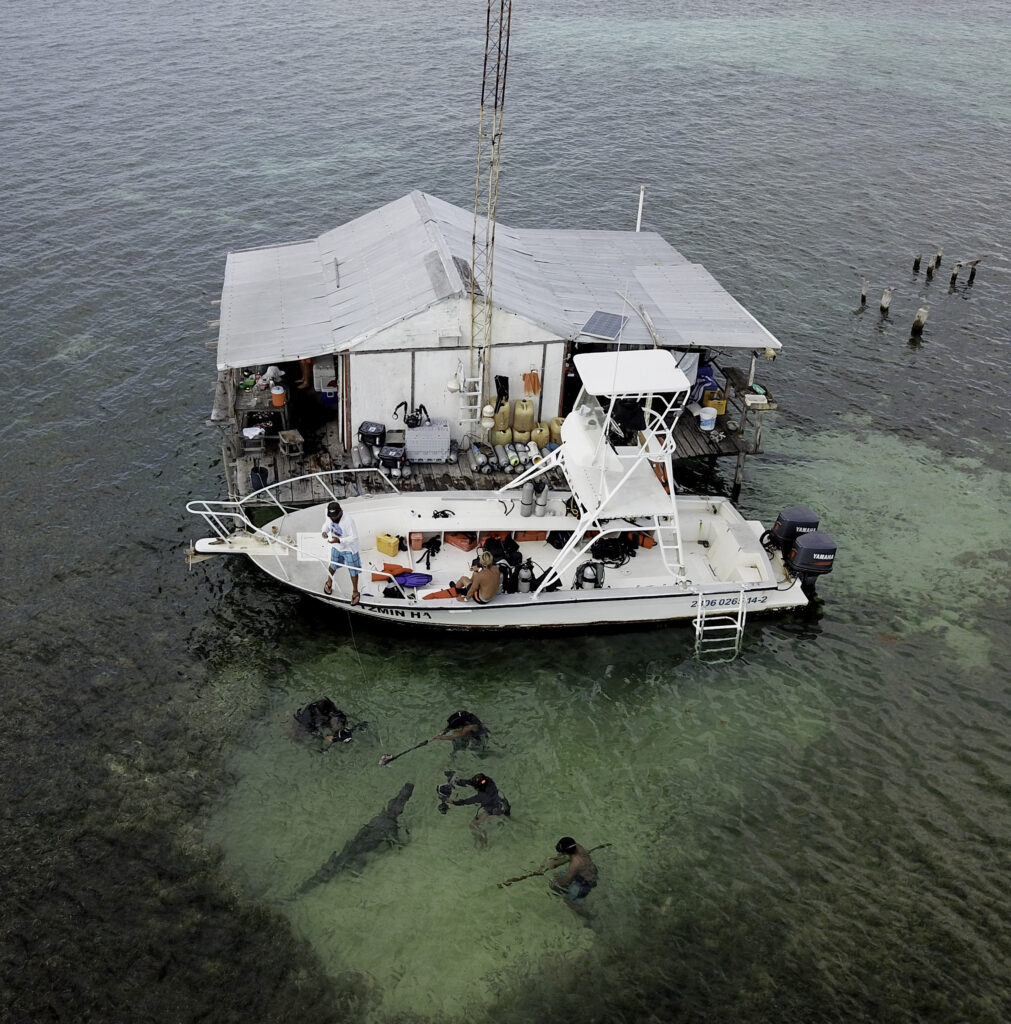
This is a true adventure for an experienced scuba diver and underwater photographer.
The highlight is being in the shallow water with the curious crocodile just meters away and sitting still on the bottom with its mouth open and crooked white teeth forming a menacing grin, but like all good adventures, the journey is as noteworthy and the end goal.
The journey begins with an arrival in Cancun then traveling south almost to the Belize border to the town of Xcalak. We make our base here and enjoy a day of diving on their pristine reefs where we see schools of resting tarpons, pristine reefs, large schools of fish, and a passing manatee. These are some of the prettiest and healthiest reefs I have seen in the Caribbean area. Our 2nd day we transfer to the Banco Chinchorro Marine Park where the American Crocodile population lives among the shallow islands and sea grass beds. We are 3 hours out to sea and have packed everything we need with us. Our base will be a rustic fishing hut standing over the shallow water and near to other huts housing working fishermen. We will have no signal, a small generator, hammocks, and only what we brought with us for the next two nights. This is what makes a great adventure: a departure from everyday habits and the opportunity to tune into something different and concentrate just on the moment and what is new around you: the crocodiles and the life at the atoll.
Ecotourism done right
Most of us have traveled to a location and lamented or became angry because limits on numbers of boats and rules for encounters with wildlife do not exist or are inadequate.
These crocodile expeditions are the example of eco-tourism done right: it has been well planned and controlled from the start, has a positive impact on the Marine Reserve where it happens, involves locals and enhances their ability to live within and protect their wild spaces.
Only one outfitter has permits to take guests and groups are limited to 6 people. An expedition to snorkel with the crocodiles at Chinchorro is supporting the local community and brings more awareness to both the area and the crocodiles. The tourism and ecological value placed on the marine reserve encourages locals to make efforts to protect their environment and live in harmony with it.
The crocs live in the UNESCO Banco Chinchorro Bioshsphere Reserve: the largest coral atolls in the northern hemisphere. This area is a shallow mangrove swamp; the perfect habitat for the reptiles. They feed on the plentiful fish then languish in the shallows waiting the chance to get scraps from the fishermen.
The marine reserve has a problem which guests help with – the invasive lionfish. Each day we dive on the beautiful reefs on the marine reserve with the dual purpose of enjoying the reef and hunting the lionfish. Guides and guests spear and collect the lionfish for use has bait to encourage the crocodiles close to our fish hut and guests. We also collect extra, if possible, to use in our afternoon treat of ceviche.
The crocodiles are a stable and year-round population. The ones we encounter are averaging 10 ft but we may have a special visit from the 14ft individual. The expeditions happen in the summer months.
Safety
This activity is heavily regulated and every possible step goes into planning this trip to ensure human and animal safety. The shallow and clear water surrounding the fish hut is where we have the encounters. One or two guests plus at least one guide/handler are in the water at a time. The handlers have learned to read the croc behavior and recognize individuals. From their years of experience, they know that the younger crocs are more unpredictable and thus the more dangerous. The older ones look fierce and threatening with their scars and missing teeth but are not aggressive and behave much calmer in this situation. The in-water guides never take their eyes off the crocodile anticipating a possible spring to action and allow the crocodile to have space so as not to feel threatened. A large plastic pipe creates a barrier between the croc and the guests in the water should the croc start to show discomfort. It is believed that the crocs are curious but wary because a guest holding a camera and big dome port is the biggest and strangest thing they have seen in the water. They want to investigate but stay cautious.
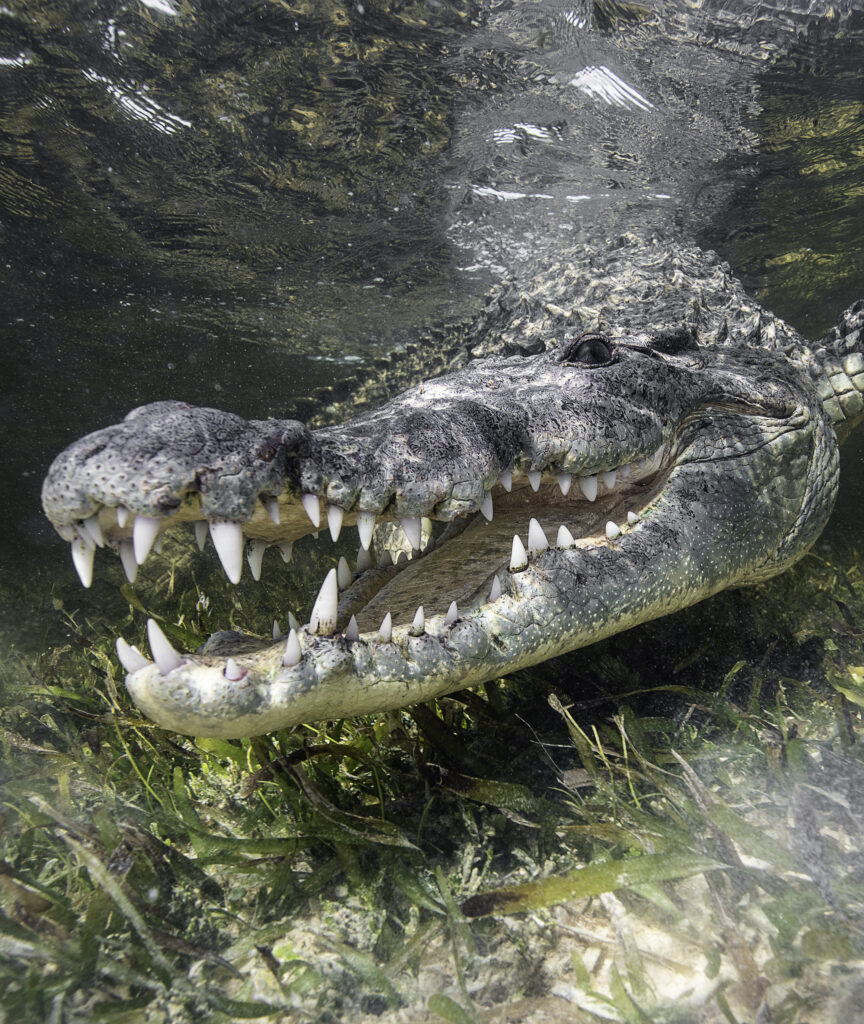
Photography Guide
Underwater encounters with big animals usually involve moving and sometimes at great speed and unpredictably. Being ready is a big element to a successful photography session. In contrast, reptiles including the American crocodiles of Banco Chinchorro are still yet resonate a coiled-up energy like a mousetrap set and ready to go off. This is a different type of being ready for anything that involves trusting the guide to read the croc and act when needed. Even with this trust you will feel a nervous tension as you maneuver closer to the croc; this is just not something one is used to but it is possible gain nice close up and tight shots safely
Equipment used for the Crocodile Encounters
Camera. Canon 5D MKIV
Housing: Nauticam with glass dome port
Lens.
Canon EF15mm F2.8 fisheye
Canon 16 – 35mm f/2.8L II USM
Strobes
Topside Lens: Canon 70 – 200mm f/2.8L IS USM (not essential, substitute a nice phone camera)
Drones are welcome: a fly over of the atoll is beautiful and the crocs can be seen in the shallows from above. A polarizer would be a good accessory for the bright days.
Strobes are allowed. I used them very lightly with just a small puff to light up the underside of the crocs. Strobes came in handy for the tarpon and manatees seen on the dives.
Try a variety of compositions to highlight the anatomy and behavior of the crocs
Side View
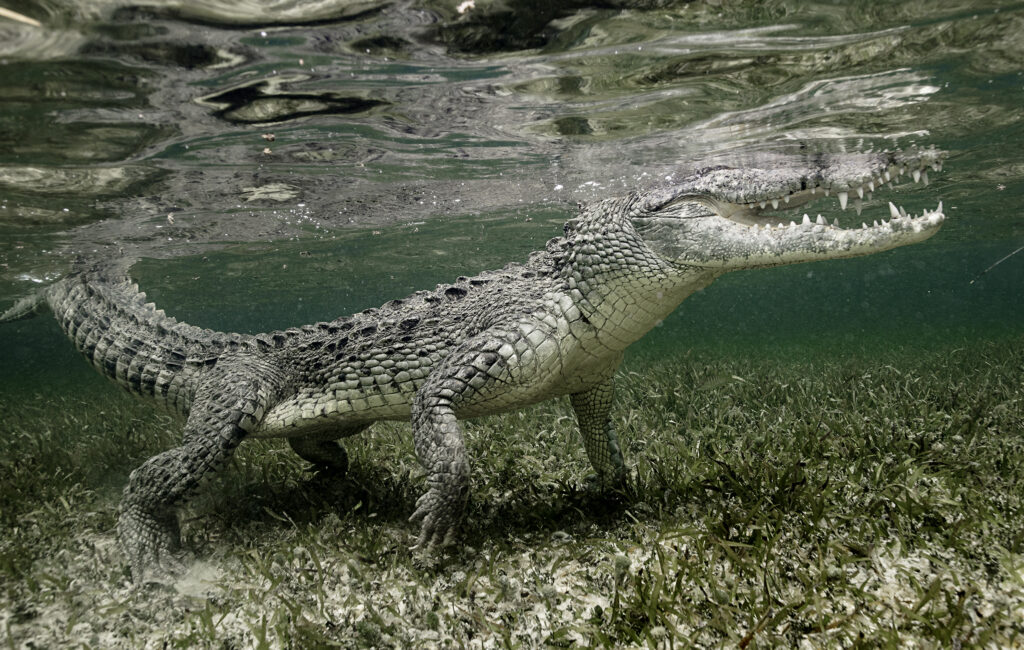
Front On
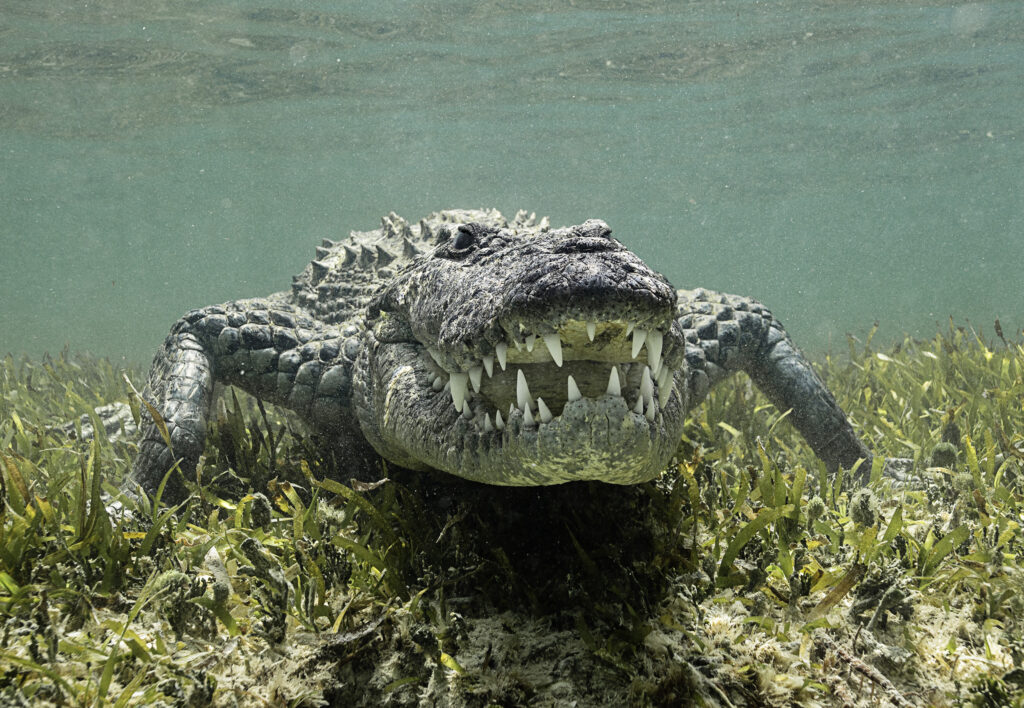
¾ Profile of Head

From Below Looking UP
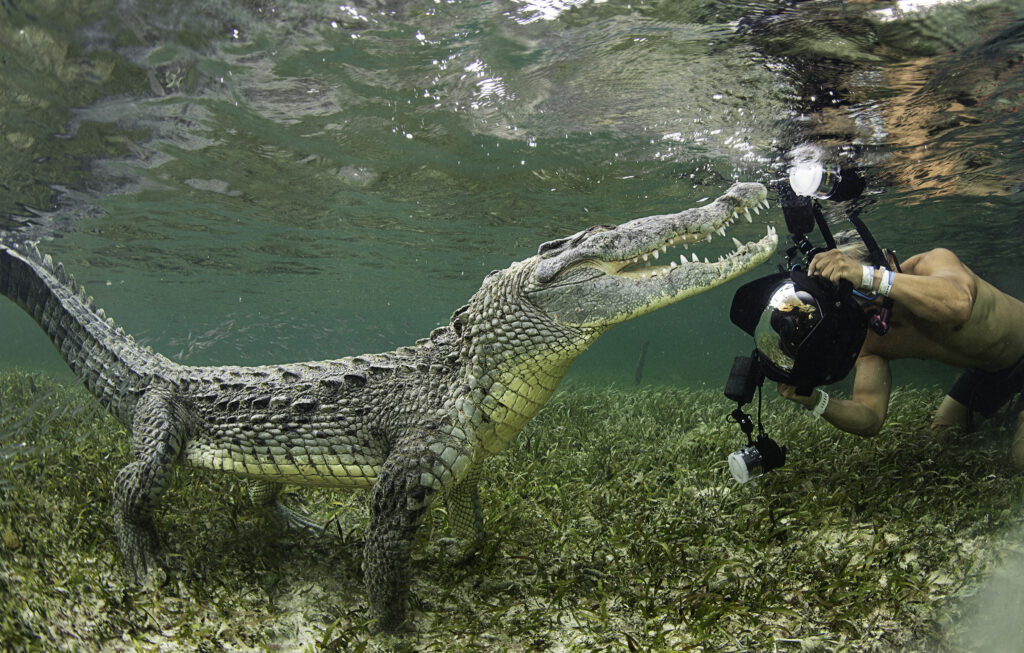
Above and below
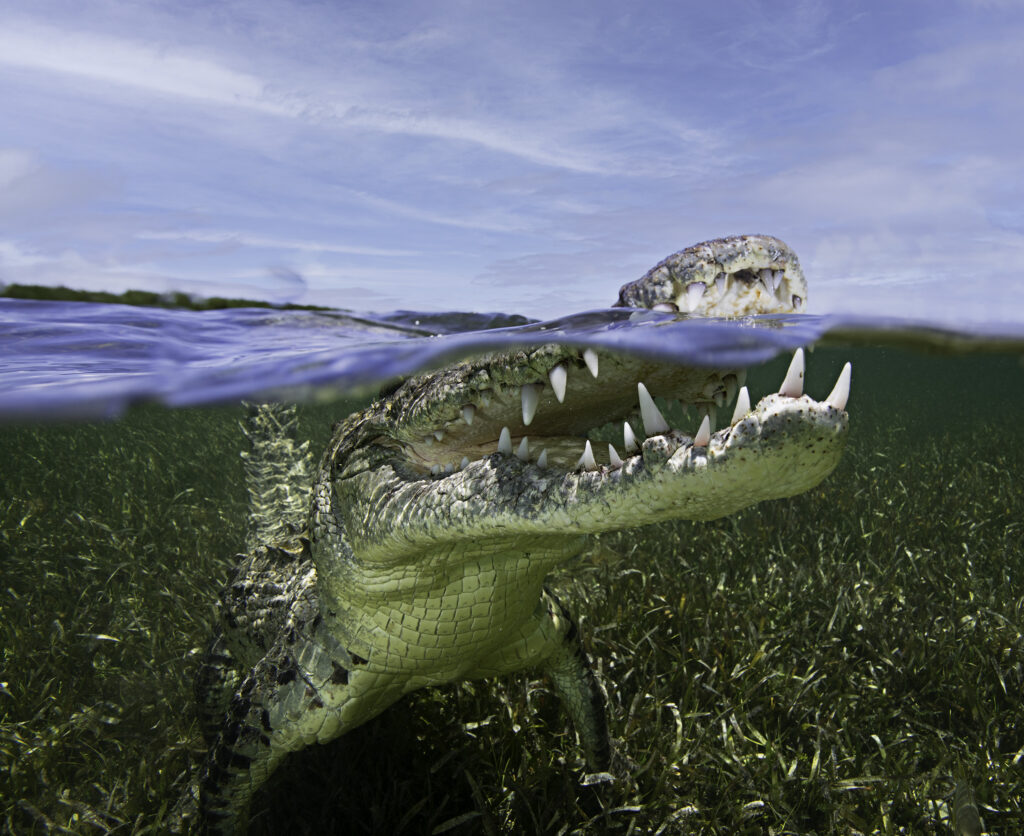
Pro tip: Before the trip, coat your glass dome port with a product “Rainx” used to make rain sheet off of car windscreens or for plastic dome ports use “pledge” furniture polish. This will minimize the chance of visible water drops on the dome port
From the Surface – Low Angle
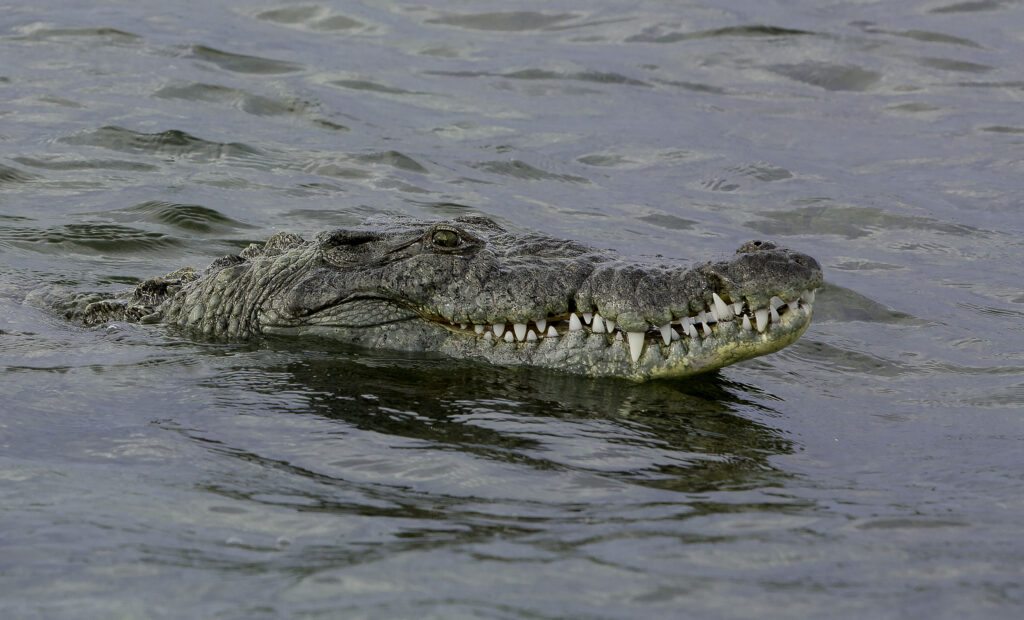
More Adventures possible than just Crocodiles
Cancun is the gateway to this exciting tourism region of Mexico. Crocodile trips are also in whale sharks and giant manta season so it is possible to head over the Isla Mujeres, the best location for reaching the whale shark aggregation, for a few days of snorkeling with the gentle giants.
Just south of Cancun’s beach resorts is an area full of Mayan ruins and other cultural features including the famous sacred cenotes (freshwater caves). Playa del Carmen is on the way to Xcalak and is central to many of the best cenotes. It also has many great diving sites of its own.
It feels amazingly lucky that just 5 hours south of the well known tourism beach resort city of Cancun is a beautiful and protected marine environment where a few adventurous people can get to know a species that is mysterious, rare, and misunderstood. Time spent with the crocodiles is not only a fresh challenge for your photography, but also a chance to change negative ideas and false reputations about American crocodiles and other reptiles.
Being so close to rare and potentially dangerous predators is very fulfilling. For each guest it is a chance to be somewhere very special and the rare chance to be remote and live rustic for 2 days. This is a combination very difficult to find in the world of diving and underwater photography
See a schedule of my Crocodile Adventures and all my underwater photography Trips on my Website
